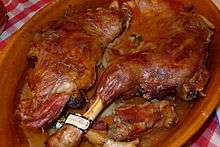Lechazo de Castilla y León

Lechazo de Castilla y León is a protected-origin food product consisting of milk-fed lamb meat, produced in Castile and León (Spain). The Geographical indication (GI) was authorized in 1997.[1] The GI encompasses 483 farms from all of the grain-producing counties of Castilla y León, producing more than 167,000 lechazos per year. The Indicación Geográfica Protegida (I.G.P.) Council headquarters is located in Zamora, Spain.[2]
The Spanish term lechazo refers to a young sheep that is still suckling (unweaned). Per the I.G.P., lechazo de Castilla y León must be of the Churra, Castellana or Ojalada breeds, and the lambs must have been fed only their mothers' milk. Lechazo meat is a highly esteemed delicacy in the region. Roast lamb and lamb chops are a prized traditional food in Castile, and a widespread dish in the region's restaurants and taverns.
Requirements at time of slaughter
- Live weight from 9 kg to 12 kg.
- Age of slaughter: up to 35 days
See also
-
 Food portal
Food portal - List of lamb dishes
- Spanish cuisine
- Castilian-Leonese cuisine
- Cuisine of the province of Valladolid
References
- ↑ Norte (22 September 2015). "La IGP del lechazo de Castilla y León aspira a certificar 200.000 canale" (in Spanish). Zamora: Norte de Castilla. Retrieved 3 February 2015.
- ↑ López, Cándido (1989). La Cocina Española (2ª ed.). Barcelona: Plaza&Janés. ISBN 9788401602016.
External links
| Wikimedia Commons has media related to Lechazo. |